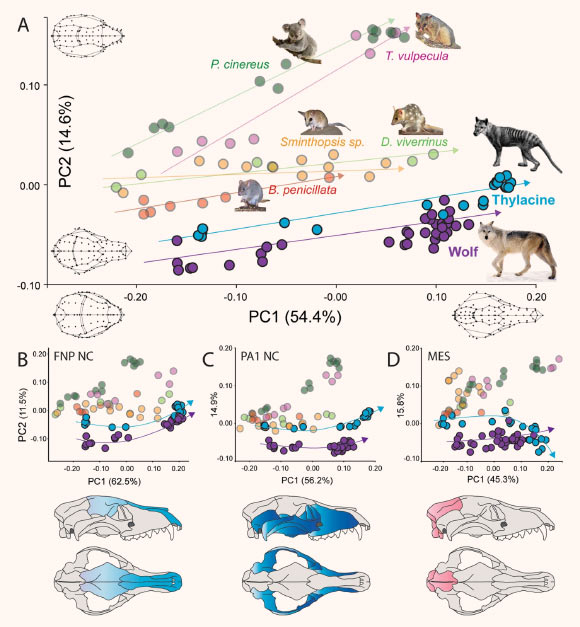Researchers in Australia have examined thylacine (Thylacinus cynocephalus) and gray wolf (Canis lupus) skulls of different ages, stages and sizes, from newborns through to fully grown adults, and compared them to those of five living marsupials. Published in the journal Communications Biology, their results show that not only did the thylacine resemble the gray wolf as adults, but were very similar as newborns and juveniles.

A Tasmanian tiger (Thylacinus cynocephalus) with three cubs at Beaumaris Zoo in Hobart, 1909. Image credit: Tasmanian Museum and Art Gallery.
When the first European settlers arrived on the remote Australian island state of Tasmania, they were astonished to find a large, striped dog-like animal which, unlike other canids, had an abdominal pouch where it reared its young.
Appropriately named Thylacinus cynocephalus, translating to ‘pouched-dog dog-headed,’ the marsupial thylacine displayed remarkable similarities to placental canids, despite last sharing a common ancestor over 160 million years ago.
The thylacine and the gray wolf are considered one of the most striking cases of convergent evolution in mammals, independently evolving nearly identical skull shapes in response to shared carnivorous and predatory ecologies.
“We know that the thylacine and wolf look similar as adults, but we don’t know when they started to exhibit their remarkable similarities during development,” said lead author Dr. Axel Newton, a researcher in the School of Biomedical Sciences at Monash University, the School of BioSciences at the University of Melbourne, and the Department of Sciences at Museums Victoria.
“All marsupials, including the thylacine, are born with unusually well-developed jaws relative to the rest of the head,” added co-author Dr. Vera Weisbecker, a scientist at the College of Science and Engineering at Flinders University.
“Scientists think that this reduces the potential of marsupials to evolve some extreme skull shapes. However, it clearly did not prevent the evolution of the thylacine’s unusual wolf-like skull!”
“Our research shows how 3D imaging can reveal hidden diversity in nature,” said senior author Dr. Christy Hipsley, a researcher in the School of BioSciences at the University of Melbourne and the Department of Sciences at Museums Victoria.

Ontogenetic cranial variation and mosaic evolution: (A) principal component analysis of ontogenetic cranial shape for each species included in the study; PC1 represents age-related shape change (left to right), whereas PC2 separates herbivorous and carnivorous species; the thylacine and wolf display parallel similarities throughout ontogeny, compared with other marsupials; (B-D) subsampling of cranial shape into bone groups with shared embryonic tissue origins; the thylacine and wolf show shape overlap between bones of (B) FNP and (D) MES origin, but not in bones of (C) PA origin. Image credit: Newton et al., doi: 10.1038/s42003-020-01569-x.
Using X-ray computed tomography and preserved museum specimens, the researchers compared the skulls of the thylacine and the gray wolf across their early development and into adulthood.
Additionally, they examined the skulls of five extant marsupial species: the brush-tail possum (Trichosurus vulpecula), koala (Phascolarctos cinereus), woylie (Bettongia penicillata), Eastern quoll (Dasyurus viverrinus), and dunnart (Sminthopsis sp.).
“By comparing entire growth series from newborns to adults, we were able to visualize tiny differences in development that pinpoint when and where in the skull adaptations to carnivory arise on a cellular level,” Dr. Hipsley said.
“That is only made possible through museum loans of preserved specimens, in this case from as far away as Alaska.”

Network diagrams of module covariation patterns during ontogeny: pairwise covariance ratio (CR) coefficients between cranial landmark modules for the thylacine and the gray wolf on neonate, juvenile, and adult 3D rendered skulls; low CR values are expressed by warm colors, indicating modularity, whereas cool colors represent high CR values, suggesting integration; neonatal and juvenile modules show high CR ratios (integration); the adult thylacine retains an integrated facial skeleton, while the adult wolf skull becomes modular. Abbreviations: Ba – basicranium, Mo – molar, OF – orbitofrontal, ON – oral-nasal, Va – vault, ZP – zygomatic-pterygoid. Image credit: Newton et al., doi: 10.1038/s42003-020-01569-x.
“Remarkably, the Tasmanian tiger pups were more similar to wolf pups than to other closely related marsupials,” added co-author Professor Andrew Pask, a researcher in the School of BioSciences at the University of Melbourne and the Department of Sciences at Museums Victoria.
The study complements earlier findings that the thylacine and the gray wolf have evolved similar instructions in their genome, which influence cranial stem cells during development.
_____
A.H. Newton et al. 2021. Ontogenetic origins of cranial convergence between the extinct marsupial thylacine and placental gray wolf. Commun Biol 4, 51; doi: 10.1038/s42003-020-01569-x







